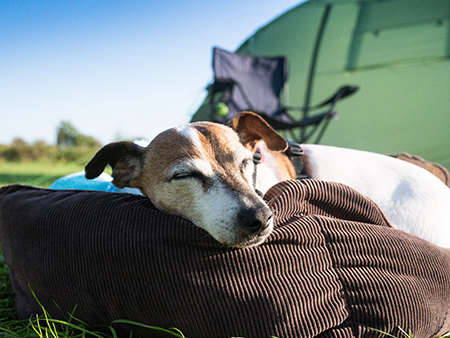Summer Camping Tips For Your Dog
Topics | Dogs, Summer, Camping
Posted | July 10, 2019

Our dogs can be great companions while hiking, camping or traveling - so here are a
few tips to review prior to packing your tent.
Before your Trip: Talk to your veterinarian and make sure your dog is healthy and up
to date on all required vaccinations, particularly rabies. Ask your vet whether your
dog should be vaccinated against Lyme disease, which is a tick-borne disease. Discuss
appropriate flea and tick control. Be sure your dog is protected against heartworms,
which are transmitted by mosquito bite and have been reported in all 50 states,
according to the American Heartworm Society.
Updated ID: Have an appropriate collar or harness with an identification tag, use a
cell phone number where you can always be reached (not a home phone number), and
include an address as some campgrounds don't have cell towers. Make sure your dog
is micro-chipped. Keep an updated photo of your dog on your phone in case you need
to make "lost posters."
What to Pack:
- Food and Water. Bring enough dog food and water for your pooch. You'll
want to bring his food bowls as well, so he has something to eat out of. If you
plan on hiking, it may be a good idea to bring a collapsible bowl so your dog can
re-hydrate while he's on the trail too. Do not allow your dog to drink from any
standing water, it can be harmful. Put away all food when your dog has finished
eating, wild animals will raid it just like human food.
- Poop Bag. For the environment and other campers, always clean up after
your dog.
- Long Leash and Carrier. Bring your dogs' regular leash for hiking and
walking, but bring a much longer leash, cable or tether so that they can securely
roam around the campsite and check things out. Also bring a carrier if you need to
confine the pet for a period of time.
- Reflective collars, glow stick, and solar powered outdoor lights. Any
drug store or home improvement store should sell a standard glow stick (or light
stick) that you can manually activate by bending the stick and mixing the chemicals
inside to wrap around the dog collar or have a reflective collar/leash. Also bring
along inexpensive solar powered lights to stake around the campsite.
- First Aid & Health Records. Take a copy of your dog's health records
and vaccination reports, especially important if you are crossing state lines. Be
prepared for first-aid, snake bites, cut paws, etc. Ask your veterinarian for
details.
- Backpacks: Depending on size, your dog should be able to carry his or
her own food and water and there are a number of dog backpacks. See the resources
listed below.
- Protect their paws: Most dogs should be fine but consider the terrain
as their paws could be easily hurt. Consider special dog booties for those areas.
What to Do with Your Dog While Camping:
- Try Sleeping with your Dog. This will keep them safe, warm and hopefully
quiet. It is not wise to keep your dog outside with the threat of other animals
and unfamiliar distractions.
- Other Animals. You should always be aware of what other types of animals
(domestic and wild) might be around when you're camping. Keep in mind that there
may be other dogs at the campground, people horseback riding on the trails and
little critters that your dog might like to chase running just about anywhere
outside. Be prepared for the other types of animals that your dog could encounter
on the camping trip. If you are unsure, stop by the ranger's station and ask.
- Don't allow your dog to drink standing water. Do your research to make
sure there's going to be plenty of water to filter where you'll be backpacking.
Be sure to pack enough for both of you if there's nowhere to get more. Dogs are
susceptible to giardia protozoa much like humans, so be sure to filter and/or
treat their water just as you would if you were going to consume it.
- Hiking. Do your homework and make sure the area allows pets. You don't
want to get to the trailhead with an excited pooch only to have to turn around
and take her back to the car because she's not allowed on the trail. Below is
a link to pet-friendly campsites in the U.S.
- Keep close by. Keep your dog close to you during your camping expedition.
If you are unable to supervise your dog, be sure he is properly confined. Provide
a carrier, crate, or portable fencing unit instead.
- Ticks, thorns, burrs. While camping, check your dog's fur and skin
regularly for ticks as well as for plant material like thorns or burrs. Plant
materials should be brushed free of your dog's hair, if possible. In some
situations, cutting or shaving the hair may be necessary to remove these
items. Remove ticks promptly by grasping the tick near the skin and pulling
gently and slowly away from the skin. Wear gloves when doing so. Do not handle
ticks with bare hands as they can transmit diseases to you as well as to
your dog.
Camping with your dog can be a lot of fun for you, your family and friends and, of
course, your dog. As long as you follow these basic steps, camping with your dog
will be a great experience for you and for her.
Resources:
Dog-friendly campsites:
http://petfriendlytravel.com/campgrounds
Hiking with your dog:
http://www.rei.com/learn/expert-advice/hiking-dogs.html





